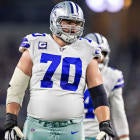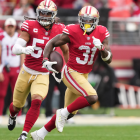The Steelers and running back Le'Veon Bell were unable to reach an agreement before the July 16 deadline for franchise players to sign long-term deals. Bell, who was designated as a franchise player for a second-straight year, is scheduled to make a fully-guaranteed $14.544 million this season. The Steelers are prohibited from signing Bell to a multi-year contract until after the 2018 regular season, which ends on Dec. 30.
The question now becomes, what's next for Bell?
Just like last year, negotiations went to the 11th hour. According to NFL Media's Ian Rapoport, Bell rejected a five-year, $70 million deal containing a $10 million signing bonus. Slightly over $33 million of the money was in the first two years. The three-year cash flow was $45 million. Adisa Bakari, Bell's agent, said the report wasn't accurate during a Sirius XM NFL Radio appearance on Tuesday without revealing the final offer. ESPN's Adam Schefter reported the five-year total as $75 million.
Once the deadline passed, Bell tweeted that "2018 will be my best season to date" while reaffirming his desire to retire with the Steelers. Bakari anticipates that 2018 will be Bell's last season in Pittsburgh. Steelers vice president and general manager Kevin Colbert doesn't seem to have closed the door on Bell remaining with the team beyond this year. He issued a statement indicating there will be an attempt to sign Bell long-term after the season.
Why there isn't a deal
Bakari contends that the Steelers were more interested in paying the running back position instead of his client. Unfortunately for Bell, NFL players are paid according to position. The primary exceptions to the positional salary constraints are those who can consistently put pressure on opposing quarterbacks. Such players are paid a premium whether they're a 4-3 defensive end, 3-4 outside linebacker or interior defensive lineman.
Bell's exact financial demands as the deadline approached haven't been disclosed. He reportedly wanted the same $17 million per year that wide receiver Antonio Brown got from the Steelers in a contract extension last year during the early part of the offseason. The three-time All-Pro alluded to needing $15 million per year in a rap song last year.
Desperately wish you had a 30-minutes-or-so, daily NFL podcast in your podcast app every morning by 6 a.m.? Put some Pick Six Podcast in your life and join Will Brinson as he breaks down the latest news and notes from around the league, as well as the win totals on a team-by-team schedule. It's a daily dose of football to get you right for that commute or gym trip. Subscribe: via iTunes | via Stitcher | via TuneIn | via Google Play
Bell can make a legitimate case that he should be compared to game's highest-paid offensive playmakers since he is arguably the NFL's most dangerous offensive weapon thanks to his running ability and receiving skills. He is amassing yardage at a historic and unprecedented rate. Bell's 129 yards from scrimmage per game are the most in NFL history (minimum of 50 career games). Hall of Famer Jim Brown is second with 125.5 per game. Nobody has ever been better at picking up yards during the first five seasons of their NFL career. Edgerrin James (126 yards per game) and Eric Dickerson (125.7) are right behind Bell.
Pittsburgh's offer demonstrated a willingness to dramatically reset a running back market that has been steadily declining in recent years. The current benchmark is the five-year, $41.25 million extension with slightly over $22 million in guarantees Devonta Freeman received from the Falcons last August.
It's a far cry from the salary landscape that existed in 2011 after Adrian Peterson and Chris Johnson signed extensions with the Vikings and Titans in the $14 million-per-year neighborhood. The deals put Peterson and Johnson among the NFL's five highest paid non-quarterbacks.
At $15 million per year, Bell's deal would have averaged slightly over 80 percent more than Freeman's contract. There would have been only six offensive playmakers, all wide receivers, with a higher average yearly salary. Among the six are Brandin Cooks (Rams), Jarvis Landry (Browns) and Sammy Watkins (Chiefs), who aren't nearly as highly regarded as Bell.
The structure of the offer was a big obstacle that couldn't be overcome. This is because Pittsburgh contracts typically have a vanilla structure. With the exception of quarterback Ben Roethlisberger, the only guaranteed money in Pittsburgh deals is a signing bonus. Roethlisberger's base-salary guarantees are for injury only. The bigger deals contain a third- or fifth-day-of-the-league-year roster bonus in the second and third years. The roster bonuses are supposed to be substitutes for additional contract guarantees. The overall guarantees in Pittsburgh contracts are usually less than comparable deals to those of other teams.
Bell's reported $10 million signing bonus seems low by Pittsburgh standards. Brown received a $19 million signing bonus, which is his only true guaranteed money. His deal also had $6 million and $2.5 million fifth-day-of-the-league-year roster bonuses in 2018 and 2019. The $10 million-per-year extension All-Pro guard David DeCastro signed right before the start of the 2016 regular season had $16 million treated as signing bonus under the salary cap.
When will Bell show up?
Bakari confirmed during his radio appearance that the plan is for Bell to take the same approach as last year. Bell didn't sign his franchise tender in 2017 until Labor Day, which is Sept. 3 this year. Players under contract can be fined a maximum of $40,000 for each day of training camp missed. This penalty doesn't apply to unsigned draft picks or players with restricted free-agent, transition or franchise tenders who aren't under contract, like Bell, who skip training camp altogether or come late. Their attendance isn't required because of the absence of a signed contract. Unsigned players aren't withholding services they are contractually obligated to perform.
Bell's status after the season
Bell will become an unrestricted free agent next offseason after making $26.664 million on two franchise tags, provided he isn't given the seldom-used transition tag or a third and final franchise tag during the designation period -- which runs from Feb. 19 to March 5 in 2019 -- or a long-term deal is worked out before the 2019 league year begins on March 13. Free agency is the most likely scenario since Bell seems intent on finding his true value on the open market.
Bell won't get franchised for a third time. The procedures outlined in the NFL's Collective Bargaining Agreement dictate that Bell's third tag will be the greater of 144 percent of his second franchise designation or the largest number at any position, which is almost always quarterback. Assuming the 2019 salary cap is in the $190 million neighborhood, the quarterback number should be approximately $25 million.
Bell's transition number would be $17,542,800, which is 120 percent more than his current franchise tag. The Steelers have made the most extensive use of the transition-player designation in recent years. Offensive tackle Max Starks and outside linebacker Jason Worilds played under the designation in 2008 and 2014.
A transition tag would provide the Steelers only a right to match an offer sheet from another team. There wouldn't be any draft-choice compensation, like with the non-exclusive franchise tag, if the Steelers didn't exercise their matching rights. Although the Steelers would be vulnerable to an offer sheet with a structure that isn't consistent with their other contracts, it would be a way for both sides to find out what Bell is worth.
The DeMarco Murray factor
Using the average of Rapoport and Schefter's deal totals ($72.5 million), Bell is essentially betting that there will be a team willing to pay him at least $57.956 million on a four-year deal, which has a $14.489 million average yearly salary. It's the break-even point from the Pittsburgh offer minus this year's franchise tag. Bell shouldn't have any problem getting more than the $10 million fully guaranteed reportedly offered considering Freeman's deal has just under $17.3 million secure at signing.
Bell is taking a calculated risk because free agency has largely been disappointing to running backs with big salary expectations or trying to capitalize on an outstanding performance over the last few years. DeMarco Murray is a prime example.
After a tremendous season in his contract year, Murray wasn't able to monetize his success as much as he could if he played practically any other position because of the devaluing of running backs.
Murray was named 2014's NFL Offensive Player of the Year after breaking Emmitt Smith's single-season Cowboys rushing record by gaining 1,845 yards on the ground in 392 carries, the eighth-most carries ever in an NFL regular season. He had another 44 carries in the playoffs to bring his total to 436 rushing attempts. Murray tied for the NFL lead in rushing touchdowns and had the most yards from scrimmage in the league. He also broke Jim Brown's 56-year-old NFL record of six-consecutive games with 100 rushing yards or more to begin a season with an eight-game streak.
Concerns about Murray's future productivity because of how running backs performed historically after a season with an extremely heavy workload contributed to him being unable to raise the bar financially for running backs. The Cowboys didn't offer Murray a lucrative long-term second contract because of this and a belief that he benefited from running behind a great offensive line. Murray received a five-year, $40 million contract, which included $21 million in guarantees and was worth a maximum of $42 million through salary escalators, from the Eagles in 2015 free agency. The deal made Murray the NFL's sixth-highest-paid running back by average yearly salary. Murray, who played the last two seasons with the Titans, announced his retirement from the NFL last week at age 30.
Bell is expected to have a high-mileage season provided he stays healthy. He led the NFL with 321 rushing attempts and 406 touches (combined receptions and rushing attempts) in 2017 despite sitting out the season finale for precautionary measures with the playoffs looming.
Potential 2019 suitors
Bell, who will turn 27 in February, could be an exception to conventions because there hasn't been a running back as talented as he is to hit the open market in recent memory. He doesn't necessarily need to generate a lot of interest in free agency to collect on the bet he is making on himself. It takes only one team that shares his point of view about his talents.
The 2019 salary cap should be in the $190 million neighborhood if the growth rate of the cap from recent years continues. The Colts are projected to have approximately $116 million in cap room, an NFL best, next offseason. Only four teams have fewer than the almost $125.4 million of 2019 cap commitments that the Colts have. They are also on track to have the second-most carryover cap room with slightly over $51 million.
The Colts don't have a proven running back on the roster after letting 35-year-old Frank Gore sign with the Dolphins in free agency. 2017 fourth-round pick Marlon Mack, who has 93 career carries, enters training camp with the inside track to replace Gore.
The Jets could have in excess of $100 million of cap space when the 2019 league year starts next March. Bilal Powell, who led the Jets with 772 rushing yards in 2017, is in a contract year. The Jets signed Isaiah Crowell to a three-year, $12 million contract in March but his presence shouldn't have an impact on a pursuit of Bell unless he produces this season like Hall of Famer Curtis Martin, the last great Jets running back.
The Texans have the NFL's most run-oriented offense over the last three years with a league-leading 1,236 rushing attempts. Lamar Miller probably won't get an opportunity to finish the four-year, $26 million contract he signed in 2016 if he doesn't improve upon the 3.7 yards per carry he had last season. The Texans are projected to have slightly over $83 million of cap room in 2018. $6.25 million of cap space would be gained from cutting Miller next offseason.
The Browns will be frequently mentioned as a destination for Bell because he would be reunited with Todd Haley, who became Cleveland's offensive coordinator when the Steelers fired him after an upset loss to the Jaguars in last season's divisional playoffs. Haley spent the last six years as Pittsburgh's play caller. Potentially having $90 million of cap space thanks largely to what could be more than $50 million of cap room to carryover to next year will give the Browns the flexibility to move on from Carlos Hyde and Duke Johnson despite the duo signing contracts this offseason. Hyde, a free-agent pickup from the 49ers, received a three-year, $15.25 million deal. Johnson recently re-upped with a three-year, $15.6 million extension.
Bell is precisely the type of offensive toy new Raiders head coach Jon Gruden, who is essentially the main powerbroker in the organization, would love to have. The two-year contract of 32-year-old Marshawn Lynch will be coming of the books next year. Doug Martin came to Oakland this offseason on a one-year prove-it deal in an effort to resurrect his career. Oakland has a more challenging cap situation than the other teams. The projected almost $47 million of cap space doesn't factor in a massive contract for defensive end Khalil Mack, who is scheduled to play this season on his fifth-year option. Mack is expected to become a charter member of the $20 million-per-year non-quarterback club with Rams interior defensive lineman Aaron Donald.
Final thoughts
Bell is probably going to be the litmus test for how the NFL values elite running backs in free agency. A robust free-agent market will undoubtedly lead to a groundbreaking deal that will pave the way for young running backs still on rookie contracts, such as Ezekiel Elliott (Cowboys), Todd Gurley (Rams) and David Johnson (Cardinals), to fundamentally change how highly productive ones are paid. With an injury-plagued or down season, it's going to seem like Bell overplayed his hand because he might never get the money that was in Pittsburgh's last offer.

















